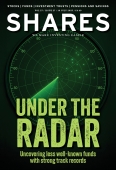Archived article
Please note that tax, investment, pension and ISA rules can change and the information and any views contained in this article may now be inaccurate.
Will there really be no more rate cuts from the Fed?

It’s that time of year when those of us who are following the markets day-to-day take stock of the first six months of 2025 and, in turn, look ahead to what we can expect from the remainder of the year.
There are plenty of moving parts to consider, one of which is the future trajectory of interest rates. This was probably the biggest single obsession for markets before the Trump administration took office and, while tariff turmoil has pushed central bank decision making somewhat into the shade, it is still central to the relative attractions of different asset classes.
After all, higher rates normally increase the appeal of bonds and cash compared with stocks and vice-versa.
With that in mind, there was a striking observation in some recent commentary from investment bank Berenberg. Economist Atakan Bakiskan noting he expects no further reductions in US rates.
Consensus forecasts still have rates dropping to a 3.5% to 3.75% range by the first quarter of 2026 from the current 4.25% to 4.5%. However, if Bakiskan is right then Trump is unlikely to be happy given the very public and unsparing criticism he has aired about Federal Reserve chair Jerome Powell. Attacking him for being too slow to ease monetary policy.
Notably, having gone harder and faster on rates than its counterparts at the European Central Bank and Bank of England in 2022, the Fed has been slower to retreat than either since the current rate-cutting cycle began last year.
As my colleague Martin Gamble observes in this week’s News section, the better-than-expected jobs numbers released on 3 July make any kind of cut unlikely at the next policy meeting at the end of this month. Might this move Trump to announce Powell’s successor ahead of the end of his current term in May 2026, as has already been speculated.
The prospect of a shadow Fed chair, with investors looking for clues as to their future intentions on rates, is one which may heighten uncertainty and provide another source of volatility in financial markets.
Elsewhere in this issue, Ian Conway tees up the upcoming US earnings season with a sideways glance at the American banking sector, whose big names are always among the first to report.
There is also a really interesting look at some of the under-the-radar funds with performance track records which would put some of their more prominent peers to shame.
Important information:
These articles are provided by Shares magazine which is published by AJ Bell Media, a part of AJ Bell. Shares is not written by AJ Bell.
Shares is provided for your general information and use and is not a personal recommendation to invest. It is not intended to be relied upon by you in making or not making any investment decisions. The investments referred to in these articles will not be suitable for all investors. If in doubt please seek appropriate independent financial advice.
Investors acting on the information in these articles do so at their own risk and AJ Bell Media and its staff do not accept liability for losses suffered by investors as a result of their investment decisions.
Issue contents
Editor's View
Feature
Great Ideas
Investment Trusts
News
- Currys shares climb to three-year high on resumption of dividends
- Scorching weather takes its toll on Hollywood Bowl
- Frasers Group targets Hugo Boss dividend policy and treasury shares
- Stock markets react with relief as tariff deadlines extended
- Musk risks alienating supporters with new political intervention
 magazine
magazine








